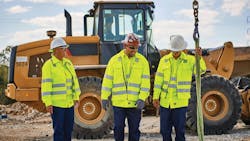Enhancing public transit worker safety with high-visibility uniforms
Public transit workers play a critical role in ensuring service runs smoothly and as expected. However, the environments in which they operate contain various hazards, from moving vehicles to poor visibility conditions.
High-visibility uniforms are essential for ensuring public transit workers' physical safety, service uptime and meeting the compliance standards set by the Occupational Safety and Health Administration (OSHA).
How high-visibility uniforms improve safety: Making workers more visible in all conditions
Ensuring workers' health and safety requires regulatory awareness, risk assessments and training. This work is often complex, time-consuming and resource intensive. Conversely, high-visibility uniforms are a simple, cost-effective solution to many of the physical hazards that public transit workers encounter in their day-to-day jobs.
High-visibility uniforms help workers stay visible and easily noticeable in various conditions, such as:
- Low-light conditions, like dawn or dusk, night-time or poorly lit workspaces.
- Fluorescent colors also ensure workers stand out during the daytime.
- Adverse weather conditions such as snow, rain or fog.
Key features of effective high-visibility uniforms: Reflective materials, weather-resistant fabrics and mobility
Here are some core characteristics to look out for in high-visibility uniforms.
Visibility
High-visibility uniforms ensure workers stay in the field of vision in two different ways:
- Fluorescent materials: High-visibility uniforms typically use bright fluorescent yellow or day-glo colors. These hues help workers stand out against any background even in the driver’s peripheral vision.
- Retroreflective elements: This workwear also features retroreflective strips or materials that reflect light back to its source, allowing workers to be easily seen in low light or darkness.
The American National Standards Institute (ANSI) and the International Safety Equipment Association (ISEA) set the U.S. high-visibility safety apparel standards. The ANSI/ISEA 107-2020 outlines different performance requirements for high-visibility safety apparel for occupational users. The two main types that are relevant to public transit worker safety are:
- Type O (Off-Road): Environments with moving vehicles but not roadway traffic.
- Type R (Roadway): Areas with roadway traffic or temporary traffic control zones.
The ANSI/ISEA 107-2020 also classifies high-visibility safety apparel on the basis of visibility. Uniforms come in Classes 1, 2 or 3. Public transit workers usually use Class 2 (intermediate visibility) or Class 3 (Highest visibility).
Water resistant fabrics
Public transit workers need to work in a variety of conditions during both day and night. As such, high-visibility clothing should be water-resistant. The garments should also be durable enough to resist wear and tear while keeping their high-visibility luminosity over the long haul.
Mobility
Finally, comfort is important when it comes to ensuring workers want to wear high-visibility uniforms. Garments should fit properly and allow public transit workers a full range of movement and mobility. Uniforms should never be a barrier to workers performing their tasks.
Real-world benefits for transit workers: Preventing accidents, complying with regulations and improving confidence
High-visibility clothing offers tangible benefits for public transit workers. Let’s explore a few of the primary reasons why they’re essential workwear.
Accident prevention
Public transit workers operate in areas with traffic, making them vulnerable to being stuck by vehicles. What’s more, adverse weather conditions also put them at risk. Worker visibility reduces the likelihood of these types of accidents. This effect is not limited to night time or low-light conditions but also during the day, thanks to fluorescent clothing.
Regulatory compliance
Many transit agencies and regulatory bodies mandate high-visibility clothing in particular work environments.The ANSI/ISEA 107-2020 standard governs countrywide regulations but some states and municipalities have their own additional requirements.
If transit agencies want to avoid OSHA citations and fines, they need to:
- Provide appropriate high-visibility clothing for workers.
- Train workers on the use and care of these safety-focused uniforms.
- Ensure garments meet the relevant standards.
- Inspect and replace worn or damaged uniforms.
Worker confidence
Worker confidence is an underrated benefit of high-visibility uniforms. When public transit workers are visible, they can better focus on their work because they’re less worried about accidents.
However, it’s not just that workers feel less stress when they’re visible; highvisibility uniforms also make the public feel more trust in workers, which in turn can give transit employees more assurance when they interact with the public.
Worker identification
High-visibility clothing doesn’t just make workers more visible to drivers; it also means passengers and colleagues can spot public transit workers more quickly. This fact can improve coordination, emergency response and customer service. What’s more, if the apparel is also fitted with a brand or agency logo, it can lend an air of professionalism.
Conclusion: Why investing in high-visibility uniforms is crucial
Investing in high-visibility uniforms is money well spent. These garments boost worker safety and give employees a sense of calm, especially at night or in adverse weather conditions. When workers know that their employers prioritize their safety, it can lead to an increase in morale.
Beyond employee satisfaction, ensuring workers wear high-visibility garments is a regulatory requirement. Ignoring compliance is simply not an option for public service providers.
Finally, reducing accidents helps drive the efficiency and reliability of public transit services. At a time when environmental sustainability is the focus, anything that boosts the credibility of public transit as a viable way to commute and travel is a positive that shouldn’t be ignored.
About the Author

Nick Warrick
Sales Manager at All Seasons Uniforms.
Nick Warrick is the sales manager at All Seasons Uniforms. With more than 15 years of experience in the work uniform business, he has worked with more than 100 clients across 20 different industries. Holding bachelor’s degrees in both business administration and information technology, Warrick revamped the company’s online presence, offering its customers a new uniform shopping experience.
